Marinebeam: Ultra Long Range LED flashlight tested, MarineKinetix wind turbine admired
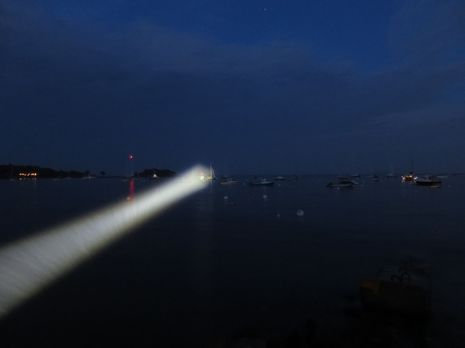 You really should click on the photo above to see the higher resolution version. With my camera on a tripod I was lighting up boats and mooring buoys about 500 to 700 yards away (460 to 640 meters) with only an LED flashlight powered by three D cells. What’s more, the beam is so tight that I was able to do this testing without blinding myself or (hopefully) anyone who was on their boat in Camden’s outer harbor last night. The Marinebeam Ultra Long Range RLT Illuminator is an unusual and useful flashlight as is, but it also demonstrates a promising technology…
You really should click on the photo above to see the higher resolution version. With my camera on a tripod I was lighting up boats and mooring buoys about 500 to 700 yards away (460 to 640 meters) with only an LED flashlight powered by three D cells. What’s more, the beam is so tight that I was able to do this testing without blinding myself or (hopefully) anyone who was on their boat in Camden’s outer harbor last night. The Marinebeam Ultra Long Range RLT Illuminator is an unusual and useful flashlight as is, but it also demonstrates a promising technology…
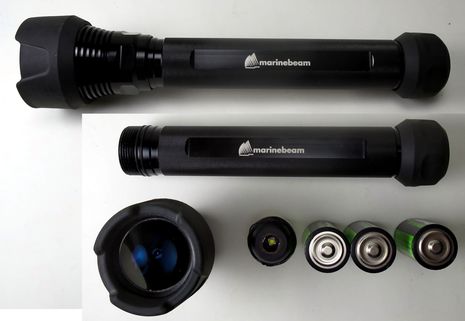 The Ultra Long Range flashlight is big at 13-inches long and it seems to be made well enough to take down a large mammal if used as a club. Marinebeam doesn’t make claims about waterproofness, but note the double O-rings where the big lens screws onto the body. The rubber-encased switch is on the tail end and cycles between full power, half power and a strobe function that would definitely get someone’s attention if your aim is good. The heart of the beast, though, is the little LED assembly you can see next to the batteries. It uses a technique called Recycled Light Technology (RLT) to multiply and collimate the relatively modest 300 lumen LED chip into a beam with a rated usable range of 650 meters, which might normally take 2,800 lumens according to Marinebeam’s detailed write-up.
The Ultra Long Range flashlight is big at 13-inches long and it seems to be made well enough to take down a large mammal if used as a club. Marinebeam doesn’t make claims about waterproofness, but note the double O-rings where the big lens screws onto the body. The rubber-encased switch is on the tail end and cycles between full power, half power and a strobe function that would definitely get someone’s attention if your aim is good. The heart of the beast, though, is the little LED assembly you can see next to the batteries. It uses a technique called Recycled Light Technology (RLT) to multiply and collimate the relatively modest 300 lumen LED chip into a beam with a rated usable range of 650 meters, which might normally take 2,800 lumens according to Marinebeam’s detailed write-up.
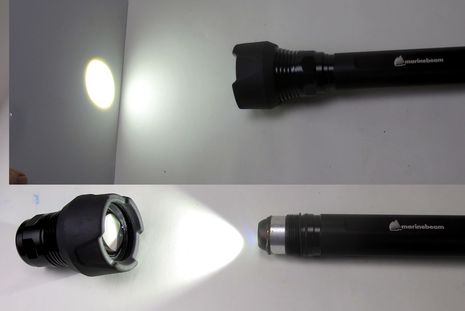 The thick reverse fisheye style lens also has something to do with how far the Ultra can throw light, as shown in this collage. Without the lens, the flashlight at least appears to have a fairly normal conical beam, but apparently the lens works with the RLT to produce that highly focused spot. Note that with the lens on, even that bit of light on the table is not spillover, but rather reflection from the white board. Note, too, that the ability to collimate 300 lumens so tightly is why this flashlight can purportedly run 12 hours at full power on three fresh D cells. According to Marinebeam’s resident geek, Jeff Field, RLT is also why this sort of long range spot beam will eventually come out in smaller, less expensive flashlights and may also work well in a high-power, pan-and-tilt marine spotlight format (stay tuned).
The thick reverse fisheye style lens also has something to do with how far the Ultra can throw light, as shown in this collage. Without the lens, the flashlight at least appears to have a fairly normal conical beam, but apparently the lens works with the RLT to produce that highly focused spot. Note that with the lens on, even that bit of light on the table is not spillover, but rather reflection from the white board. Note, too, that the ability to collimate 300 lumens so tightly is why this flashlight can purportedly run 12 hours at full power on three fresh D cells. According to Marinebeam’s resident geek, Jeff Field, RLT is also why this sort of long range spot beam will eventually come out in smaller, less expensive flashlights and may also work well in a high-power, pan-and-tilt marine spotlight format (stay tuned).
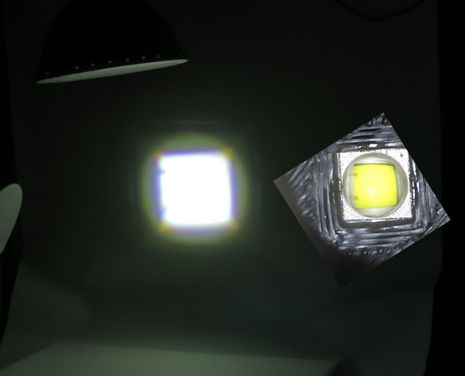 I had fun trying to photograph the Ultra’s special properties. Above is another composite, showing on the left what the Ultra beam looks like once it’s 10 feet or more from a white surface. It’s square and so sharply collimated that you can make out the two tiny electrical connectors that slightly block the Cree XPG2 Led’s surface seen to the right (inside the Ultra). I believe that the black lines around the LED are the back of the reflective material that’s pushing high-angle, spillover light back onto the LED phosphorus where it becomes more light focused across the harbor. RLT was invented by Dr. Kenneth Li, who’s working with Marinebeam and other niches (like bike lights).
I had fun trying to photograph the Ultra’s special properties. Above is another composite, showing on the left what the Ultra beam looks like once it’s 10 feet or more from a white surface. It’s square and so sharply collimated that you can make out the two tiny electrical connectors that slightly block the Cree XPG2 Led’s surface seen to the right (inside the Ultra). I believe that the black lines around the LED are the back of the reflective material that’s pushing high-angle, spillover light back onto the LED phosphorus where it becomes more light focused across the harbor. RLT was invented by Dr. Kenneth Li, who’s working with Marinebeam and other niches (like bike lights).
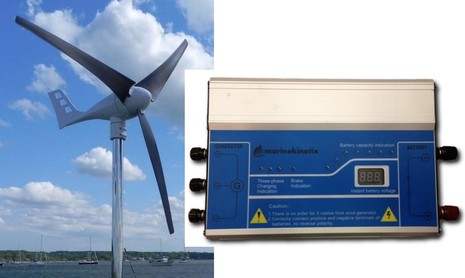 During a long conversation with Jeff Field, I learned that’s he’s not only a self-proclaimed electronics geek, but before Marinebeam he already had a lot of big industry experience sourcing technologies around the world. Now he’s built quite a business sourcing and/or manufacturing good marine LED lighting — like the running lights recently covered here — but there are other surprises if you dig around the site. He’s quite proud of the MarineKinetix MK450 wind generator, for instance, saying that while it does not involve any breakthrough technologies, every aspect of it has been improved over other turbines out there. In fact, Marinebeam claims that their generator “seriously outperforms the Air-X, Air-Breeze, Rutland, KISS, Superwind, and other much more expensive wind systems.” I like that sort of bold competitive claim, and the details seemed impressive to me, but I have no experience with wind generators. Anyone have an informed opinion about the MarineKinetix system?
During a long conversation with Jeff Field, I learned that’s he’s not only a self-proclaimed electronics geek, but before Marinebeam he already had a lot of big industry experience sourcing technologies around the world. Now he’s built quite a business sourcing and/or manufacturing good marine LED lighting — like the running lights recently covered here — but there are other surprises if you dig around the site. He’s quite proud of the MarineKinetix MK450 wind generator, for instance, saying that while it does not involve any breakthrough technologies, every aspect of it has been improved over other turbines out there. In fact, Marinebeam claims that their generator “seriously outperforms the Air-X, Air-Breeze, Rutland, KISS, Superwind, and other much more expensive wind systems.” I like that sort of bold competitive claim, and the details seemed impressive to me, but I have no experience with wind generators. Anyone have an informed opinion about the MarineKinetix system?
Finally, I was also pleased to learn about “energy harvesting” switches from Jeff. Just your finger clicking the switch can generate enough power to send a wireless signal to a relay module, no cables or batteries required. Jeff is working with EnOcean technology and will soon offer a 12v marine module that can handle enough LED lights and switches for even a large boat and can also work with CAN, Bluetooth, and other interfaces. Demo video here.


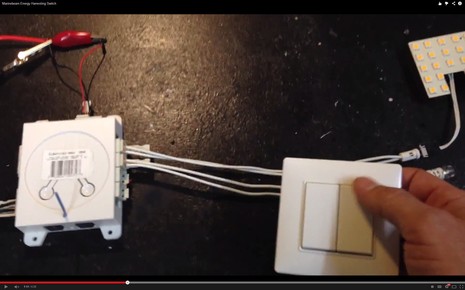


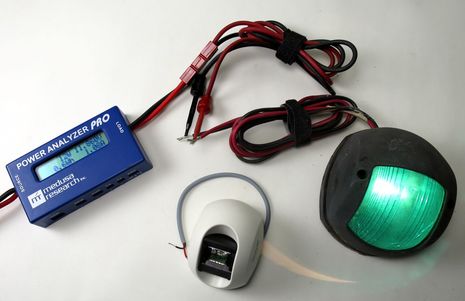
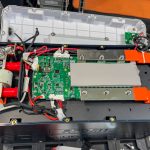







Very interesting technology.
Jeff corrected my description of what’s going on in the closeup of the RLT LED assembly:
“The light recycling collar is actually the ring surrounding, and in front of, the LED. There is nothing else, just glue and thermal compound. It is simply an inverted mirror, which redirects the spill over light back onto the LED chip re-energizing the phosphor. The light comes out the hole in the mirror. You are correct that the lens also tightens the beam, but the magic is in the collar. You will note the the light coming through the hole is now homogeneous light, without a hot spot in the center, and bright all the way to the edges. When the light is now collected by the lens, the higher angle light on the edges is also high intensity light, so the beam actually projects an image of the LED.”
The company has a good eye for innovative products. I’d be very interested in seeing how well the wind generator does in real life over a season or two. Its hard to tell from just the literature. I’d be happy to test 3 over the next winter in 20 kn average condidtions. I’m interested in multiples simply to see how well the charge controllers do not fighting with each other….or can one control handle multiple generators….
Don
Does the Illuminator have an attachment point for a lanyard? From the pictures, it appears not, but that’s a very important feature for a marine product.
No lanyard hole, Jonathan, though I think the ends are big enough you could cinch a line around the body. It can also roll on a flat surface, which isn’t great on a boat. I think that Marinebeam sourced the aluminum body parts from a company that makes tactical flashlights.
I am interested in his wind generators output. Is it 3 phase A.C. like the Coleman or does it produce DC direct? (redundant?)
Bill
Bill, it appears to come in a choice of 12V or 24V DC models, so no AC.
Actually, I was referring to the generator head itself. The Coleman unit produces a “wild” three phase output that it then converts (using inverter tech) and produces 12 or 24 VDC.
Most other makers use a PM or other such motor to generate DC and then use DC-DC converters to regulate.
I could not readily see which technology they were implementing.
Bill
I see what you mean, Bill. They do say “3-phase” on that page, but no clue where they convert it to DC. Guess you’ll have to ask them..:-)
Thanks, Ben. I have a small sailboat, so just about anything dropped on deck ends up overboard. But I also have a flashlight fetish, so I’m still very tempted.
Yes, the head is AC and then rectified by the controller inside the boat..
I hear that virtually all small wind gens are AC, then rectified.
Also, this by email from cruiser Nick:
“Impressive flashlight, but who wants to carry it around. I know you’re going to get a hundred emails about flashlights – hey, you should know not to talk about varnishing, ground tackle, single vs. twin, or flashlights.
Anyway, check out the LED LENSER L7:
http://www.ledlenser.com/uk/flashlights/l7/technical-data
Advertised: 115 lumens, 225 m luminous range, 42 hrs, 35 g, variable spot to flood, fits one hand, and three AAA. Oh yeah, costs $25.
Don’t know about the specs, but it is REALLY bright and has a long throw. Don’t look at it up close.”
I want to emphasize that the Marinebeam Ultra is really not a normal flashlight. The super tight beam might be useful in some normal circumstances, particularly at half power, but the Ultra is really a long range spotlight in flashlight form.
I can’t believe that this is a handheld flashlight. I took a look at the high res picture at the top as suggested and it gives off amazing light. I can’t wait to see the smaller versions either! What fantastic functions too, strobe lighting? Brilliant.
All wind generators that I know of are based on alternators, most with permanent magnets. Some rectify at the the alternator and majority rectify closer to the batteries saving long heavy cable runs.
Cheers
Don
Thanks guys, Are they all three phase?
And just to add to the flashlight talk, Last August I purchased a AAA 1 watt, 2 speed, momentary or always on little light that is virtually indestructible with a lanyard and “s-biner”. I always carry it in my pocket and use it every day. I hardly ever pick up a larger flashlight any more. When I do I reach for collimated beam type lights.
Cheers
I like the light and motion gobe flashlights for boats. 700 lumens. Changeable heads. Lithium batteries. Waterproof for scuba. Doesn’t have that tactical look either. Anyone have one?
3-phase alternators are the most common, and likely the only type one is likely to see
Don
Just wanted to chime in and say that I have a MarineKinetix MK450 wind gen in my shop now getting ready for an install next week.
I am pairing it with a SS Kato pole, which is stunning and extremely well engineered too.
So far the fit and finish of the Marine Kinetix is beyond what I assumed it would be. Jeff Field was excellent to deal with, as always, and he shipped it out on rather short notice, and did so promptly.
So far I am quite impressed with the MK 450, we’ll see what happens once installed.
-RC
There are lots of good LED lights on the market now. A friend and I have had a long conversation about whether a standard battery light is better than a rechargeable light. I have bought all my lights using the 18650 battery source, since they are very powerful, not too big, and rechargeable. I have several spares and can swap the battery out if I need high power for a long time.
I have seen the “collimator style lens” on some flashlights that yields a very tight beam pattern That is the only way to have a tight beam other than having a larger reflector. The larger reflector is the other way to collect all the light and create a tighter beam, which results in longer “throw” or distance.
I would recommend anyone looking for tough LED flashlights to look at EagleTac brand lights or Zebralights brand. You can pick the light output, and batteries used.
The best source I have found for just about all LED lights is http://www.illuminationgear.com
Since we’re talking about Marine uses, I would recommend getting a foam float to prevent losing it if you drop it in the water. Most are water proof to significant depths, but you still have the problem of retrieval…
My zebralight has a pocket lanyard that secures it to my wrist when there is a chance of losing it. The Zebra light has the problem of activating in your pocket, when something (keys, etc) presses the side button. Most lights have a “safety” mode that prevents the light from turning on by loosening the tail cap, so you don’t get a hot pocket.
My current favorite light is the Eagletac TX25C2 which is powered by a single 18650 battery and has a light output of 960 ANSI lumens. it has a strong side switch that I have not had a problem yet with accidental activation. It also has the tail cap safety mode too. You select the light mode (turbo, normal, or low) by twisting the head. This way, you can select the light mode before you hit the button.
There may be much better lights out there but I have not been light shopping in over a year…. Check their website and see what’s new.
Thanks, Stuart!
I’ve recently chatted with two acquaintances in this area who bought MarineBeam Ultras for their boats. Both are extremely pleased. I don’t know of a comparable handheld long range light.
Also, I am finding uses for the Ultra as a regular flashlight. My Dorcy 200 Lumen rechargable LED — which I’ve long loved ( http://goo.gl/n99ep — can show me how much water is in Gizmo’s deep and dark bilges, but the Ultra illuminates all the little junk that’s under the water and scum. I have some cleaning to do ;-0
Hey Ben, the LED flashlight revolution is on and going strong. Being a flashlight aficionado for many years, I have been very impressed with the latest generation of LED portable lights. I have a handheld 3 LED light that outputs 2700 Lumens in a very focused beam and has a rotating collar that will change the output from reading a book without disturbing the spouse to practically starting a fire on the bank. Thrunite TN 30. My lightweight fav is a great spotlight sporting 900 lumens the Jetbeam BC40 and very easy to hold and operate, only one setting, ON!
Browsing to my favorite flashlight store I now find a single LED light that outputs 2600 lumens with runtime of 2.8 hours on a charge. Digging out the wallet now. http://www.batteryjunction.com/jetbeam-wl-s4.html
Thanks for keeping us informed…
MarineBeam now has a rechargeable, much lighter, and less expensive Illuminator:
https://store.marinebeam.com/featherlight-long-range-illuminator/
Not as powerful as the original, though, and not nearly as good for decking a pirate.
I like the light and motion gobe flashlights for boats. 700 lumens. Changeable heads. Lithium batteries. Waterproof for scuba. Doesn’t have that tactical look either.